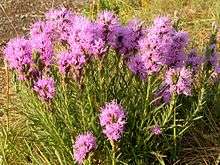Liatris punctata
| Liatris punctata | |
|---|---|
 | |
| Scientific classification | |
| Kingdom: | Plantae |
| Clade: | Angiosperms |
| Clade: | Eudicots |
| Clade: | Asterids |
| Order: | Asterales |
| Family: | Asteraceae |
| Genus: | Liatris |
| Species: | L. punctata |
| Binomial name | |
| Liatris punctata | |
Liatris punctata is a species of flowering plant in the aster family known by the common names dotted gayfeather, dotted blazingstar, and narrow-leaved blazingstar. It is native to North America, where it occurs throughout the plains of central Canada, the central United States, and northern Mexico.[1]
This perennial herb produces one or more erect stems 14 to 85 cm (6 in to 2 ft 9 in) tall.[2] They grow from a thick taproot 1.3 to 5 m (4 ft 3 in to 16 ft 5 in) deep that produces rhizomes. The inflorescence is a spike of several flower heads.[1] The heads contain several flowers which are usually purple, but sometimes white.[3] The fruit is an achene tipped with a long pappus of feathery bristles.[2] The plant reproduces sexually by seed and vegetatively by sprouting from its rhizome. This species is slow-growing and long-lived, with specimens estimated to be over 35 years old.[1]
This plant occurs in Alberta east to Manitoba in Canada, and in most of the central United States, its distribution extending into Mexico. There are three varieties, with var. punctata in western areas, var. nebraskana more common to the east, and var. mexicana in Oklahoma and Texas.[1]
This species grows in a wide variety of habitat types, including ponderosa pine forests, sagebrush, chaparral, pinyon-juniper woodland, and many types of grassland and prairie. It is drought-tolerant because of its deep roots, though it does become less abundant in times of drought. It is also fire-tolerant, able to resprout from its rhizome and disperse its wind-carried seeds to soil cleared of litter by fire. On plains and prairies it grows with many types of grasses, such as Scribner's panic grass (Panicum scribnerianum) and tumble grass (Schedonnardus paniculatus), and wildflowers such as heath aster (Symphyotrichum ericoides), tick-trefoil (Desmodium sessilifolium), and oldfield goldenrod (Solidago nemoralis). It is a host plant for the hemiparasitic wholeleaf Indian paintbrush (Castilleja integra).[1]
This plant is palatable to livestock and wild ungulates such as elk, white-tailed deer, and pronghorn. Its nectar is favored by lepidopterans, such as the rare butterfly Pawnee montane skipper (Hesperia leonardus montana), which is known to occur wherever the plant does.[1]
This species is considered good for revegetating prairie habitat. It is also used as an ornamental plant.[1]
References
- 1 2 3 4 5 6 7 Walsh, Roberta A. (1993). "Liatris punctata". Fire Effects Information System (FEIS). US Department of Agriculture (USDA), Forest Service (USFS), Rocky Mountain Research Station, Fire Sciences Laboratory. Retrieved 2011-11-26 – via https://www.feis-crs.org/feis/.
- 1 2 Nesom, Guy L. (2006). "Liatris punctata". In Flora of North America Editorial Committee. Flora of North America North of Mexico (FNA). 21. New York and Oxford – via eFloras.org, Missouri Botanical Garden, St. Louis, MO & Harvard University Herbaria, Cambridge, MA.
- ↑ "Liatris punctata". Native Wildflowers of the North Dakota Grasslands. United States Geological Survey. Archived from the original on 2012-09-14. Retrieved 2011-11-26.
External links
| Wikimedia Commons has media related to Liatris punctata. |
- Liatris punctata in the CalPhotos Photo Database, University of California, Berkeley
